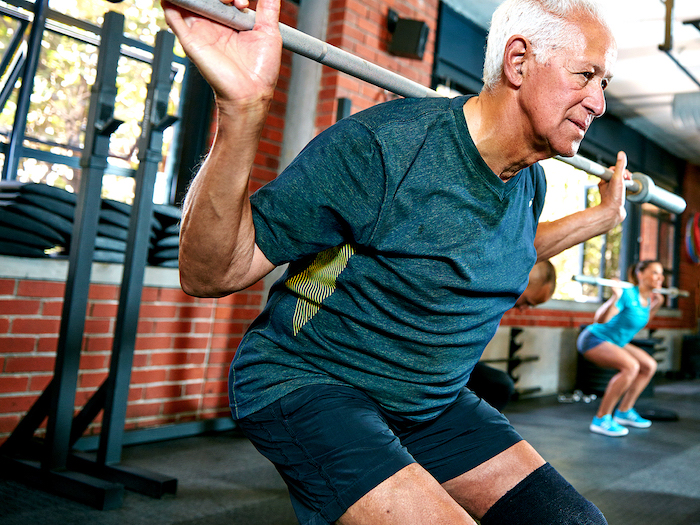4 Strength Training Mistakes You Should Fix Immediately
Get more out of every rep with these simple but essential solutions.

If strength training is part of your workout routine, go ahead and pat yourself on the back.
Strength training is one of the best habits you can keep. It helps promote mobility, keep bones strong, prevent falls, and combat cognitive decline through the years. Plus, muscle strength can be a predictor of longevity in older adults, according to a recent study in Medicine and Science in Sports and Exercise.
To reap the rewards of strength training and stay safe, it’s critical to do it properly. Here, experts share four strength training mistakes that could stand between you and your goals, plus how to fix them for better, injury-free results.
Strength Training Mistake #1: You Assume Your Form Is Good Enough
“The biggest strength training mistake I see is poor form,” says Ann Phelps, D.P.T., a physical therapist at Athletico Physical Therapy in Chicago. “Many people feel they are performing their exercises correctly, but they could be causing injuries.”
For example, while squats are one of the best exercises that you can perform in and out of the gym, leaning too far forward when you do them can put undue stress on your knees.
The solution: If you’re in a SilverSneakers class, checking your form is easy. Our instructors are trained in senior fitness. Ask your instructor to check your form. If don’t quite have it down, your instructor will likely give you tips to modify the exercise so you can do it safely.
If you’re exercising by yourself at the gym, ask one of the personal trainers walking around to quickly take a look at your form and let you know if anything is amiss, Phelps says. Don’t be shy. Most trainers are happy to answer questions if they’re not with a client, even if you never plan on signing up for personal training sessions yourself.
If you’re exercising at home, use a mirror to check your form as you move. Or ask a friend or family member to take a quick video of you so you can review it.
Strength Training Mistake #2: You Speed Through Your Sets
Trying to complete an exercise too quickly is bad for two reasons, Phelps says. First, you’ll increase your risk of injury. That’s because going quickly means you’re more likely to use momentum (for example, rocking your body to lift a weight) instead of good form (using your arm muscles to lift a weight).
Second, it actually reduces the effectiveness of your strength training sessions, Phelps says. A primary factor in exercise-related muscle growth is time under tension, or the amount of time your muscle is working hard.
The solution: Prioritize performing all movements slowly and under control, Phelps says. She adds that a two-second contraction and a two-second return to start is a good pace for most people. So, if you’re doing a biceps curl, take two seconds to curl up and two seconds to lower back down to starting position.
You may need to decrease the amount of weight you’re using so you can slow down your exercises and maintain good form. That’s completely fine! Even if you’re using less weight, you’ll get more out of every rep.
Strength Training Mistake #3: You Only Use Exercise Machines
Exercise machines can be less intimidating than dumbbells, which makes them a great option for beginners. You can also combine a few machines that target different muscle groups and create an effective total-body gym machine workout.
But focusing solely on machines may not be the best use of your time, Phelps says. That’s because they train your muscles primarily in isolation rather than compound movements—meaning that each exercise works fewer muscles and doesn’t train your body to work as one cohesive, functional unit.
What’s more, you sit at most machines, which can be good if you’re unable to stand, but most people spend too much time sitting already.
The solution: Feel free to perform some strength exercises on machines, especially if you want to isolate a muscle or don’t have the balance or strength to perform a certain exercise standing up, Phelps says.
However, it’s best to make compound standing movements, such as squats, lunges, hip hinges, and wall pushups your bread and butter, says Gavyn Berntsen, a personal trainer with the Trainerize app.
Learn more about about the best ways to use free weights versus strength machines.
Subscribe to our newsletter
It's quick and easy. You could be one of the 13 million people who are eligible.
Already a member? Click to discover our 15,000+ participating locations.
Follow Us
Strength Training Mistake #4: You Never Choose Heavier Weights
“To get the most from your strength program, you need to use weights that are going to stimulate your muscles to grow and adapt,” Berntsen says. “All too often I see older people going through the motions, and the weights are so light that they won’t get much muscle stimulus from it.”
Although something is better than nothing, he says, the results are minimal.
The solution: Know that the last few reps of every set are supposed to feel tough. If you’re able perform all your reps and sets with proper form and without feeling challenged, it’s time to increase your resistance.
If you’re performing bodyweight exercises, make things more difficult by performing more total reps, lowering farther into moves such as lunges, or adding a two-second pause at the bottom of your exercises. As soon as that becomes easier, it’s time to increase the resistance again, Phelps says.
If you’re using dumbbells, that might mean choosing a weight that is 2.5 pounds heavier, Phelps says. This guide can help you choose the right weight for strength training.
And if you’re using bands, here’s a rule of thumb: The thicker the band, the greater the resistance. This guide can help you find the right exercise band.
Check Your SilverSneakers Eligibility Instantly
SilverSneakers members can go to thousands of gyms and fitness locations across the nation, plus take exercise classes designed for seniors and led by supportive instructors. If you have a Medicare Plan, it may include SilverSneakers—at no additional cost. Check your eligibility instantly here.
Already a member? Get your SilverSneakers member ID and exclusive fitness content by logging in to or creating your online account here.





